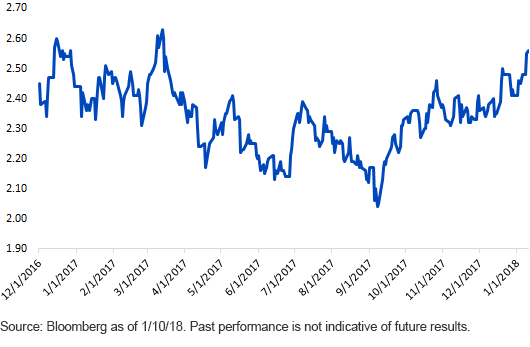
There is no doubt 2018 has gotten off to a far different start for the U.S. Treasury (UST) market as compared to the last few years. Indeed, from 2014 through 2017, the UST 10-Year note rallied in the first month or so in each year, but thus far in 2018, just the opposite has occurred. Remember, what happens in January does not necessarily dictate the trend for the remaining 11 months of the year, but given the movement of the last week or so in 10-Year Treasury yields, some perspective is needed.
Interestingly, the rise in government bond yields has not been isolated to the U.S., as essentially all of the G7 nations have seen increases. As of this writing, 10-year government yields have risen, on average, by roughly 15 to 30 basis points (bps) from their mid-December low-water marks. For the record, the UST 10-Year increase is pegged at about 20 bps and was quickly approaching the 2.60% level at one point, the highest reading since March.
U.S. 10-Year Treasury Yield

The early 2018 uptick in the UST 10-Year yield had really nothing to do with the fundamentals, namely economic data or a shift in the Federal Reserve (Fed) policy outlook. Rather, the catalyst was coming from offshore. One of the key influences to watch for in the 2018 U.S. rate outlook will be other central bank policy actions, specifically from the European Central Bank (ECB) and the Bank of Japan (BOJ). This is precisely what caught investors off guard to begin the new year.
First up, in Japan, the BOJ surprisingly announced it was dialing back on its longer-dated securities buyback program, and that was followed by reports ECB officials have been contemplating the notion of tweaking their policy guidance, with an eye on their quantitative easing program. As a reminder, the current ECB QE program was adjusted in October, when the amount of purchases was reduced to €30 billion and extended through September of this year. Obviously, the actual policy outcomes are of vital importance, but one could make the case that “how we get there?” is equally important. How the ECB and others communicate their intentions is very important to the bond market. The Fed has given investors an example of success (last year’s balance sheet normalization plan) and an example of failure (the taper tantrum).















